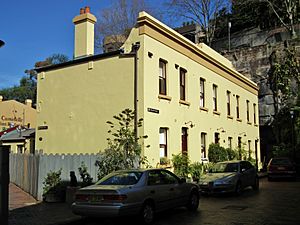Playfair's Terrace facts for kids
Quick facts for kids Playfair's Terrace |
|
|---|---|

Playfair's Terrace, located at 1-7 Atherden Street, on the corner of Playfair Street, The Rocks, pictured in 2012.
|
|
| Location | 1-7 Atherden Street, The Rocks, City of Sydney, New South Wales, Australia |
| Built | 1880 |
| Owner | Property NSW |
| Official name: Playfair's Terrace; Playfairs | |
| Type | State heritage (built) |
| Designated | 10 May 2002 |
| Reference no. | 1570 |
| Type | Terrace |
| Category | Residential buildings (private) |
| Lua error in Module:Location_map at line 420: attempt to index field 'wikibase' (a nil value). | |
Playfair's Terrace is a group of special, old houses located at 1-7 Atherden Street. They are in a historic part of Sydney called The Rocks, in New South Wales, Australia. These houses are known as "heritage-listed" because they are important to the history and culture of the state.
The terraces were built in 1880 and are also sometimes called Playfairs. They are owned by Property NSW, which is a government agency in New South Wales. Playfair's Terrace was added to the New South Wales State Heritage Register on 10 May 2002, marking its importance.
Contents
History of Playfair's Terrace
The land where Playfair's Terrace now stands has a long history. In 1834, a man named Robert Campbell was given this land. It was located above his property near the water.
Over the years, the land changed hands several times. In 1841, Campbell sold it to Frederick Wright Unwin. Later, in 1847, Unwin returned the property to Campbell's family trustees.
In 1848, Joshua Frey Josephson bought a piece of this land. He then sold it in 1852 to George Atherden, who worked at Campbell's Wharf. George Atherden built four stone cottages on one part of the land. On the other part, stables were built, but they were taken down by 1879.
In 1880, the empty part of the land was sold to Thomas Playfair. He was a butcher from The Rocks. That same year, Thomas Playfair built four terrace houses on this land.
Building the Terraces
The new houses were two storeys tall and had four rooms each. They were built with brick and cement walls. Their roofs were originally made of slate.
By 1882, Thomas Playfair had tenants living in these houses. Some of the first tenants included George Moore, Thomas Dixon, Mr. Smith, and William R. Scott.
Around 1889, an extra roof section was added to the back of each house. By 1902, the slate roofs had been replaced with corrugated iron. Later that year, Alfred Donald Playfair, who was managing the property, handed it over to the King and the Minister for Public Works.
In 1921, some nearby terraces were taken down. In 1923, Harrington Street was connected to George Street, changing the area around the terraces.
What Playfair's Terrace Looks Like
Playfair's Terrace is a continuous row of four houses. They are two storeys tall and built in the Victorian style. The houses are made of brick covered with a smooth plaster-like material called stucco.
Each house has a simple, flat top section called a parapet, which sits above a decorative ledge called a cornice. The main roof behind this is sloped (a hipped roof) and made of iron, though it used to be slate. There are also walls that separate the roofs of each house.
From the front, you can't easily see where one house ends and the next begins. The windows are rectangular, but their top corners are slightly rounded. They have simple sills that stick out a little. The front windows have four panes of glass, while the back windows have twelve.
Current Condition
As of January 2000, the buildings were in fair condition overall. This means they were in reasonable shape, but might need some repairs. The ground beneath the buildings has been partly disturbed, but the floors are level with the street.
Why Playfair's Terrace is Important
Playfair's Terrace and its land are very important to the history and science of New South Wales. They are also important because they add to the special heritage of The Rocks area itself. The Rocks is a place that is significant on its own.
Architectural Importance
The houses at 1-7 Atherden Street, along with Avery Terrace nearby, are good examples of their type and size. They fit well into the area. The terraces, combined with the rocky slope at the end of Atherden Street, create a cozy and enclosed street space. These buildings and the street space are a big part of why The Rocks Conservation Area is so historically important.
Playfair's Terrace was officially listed on the New South Wales State Heritage Register on 10 May 2002. This happened because it met certain important criteria.
Historical Significance
The terrace and its site are important for showing the history and development of New South Wales. They tell a story about how the area grew and changed over time.
Aesthetic and Technical Significance
The houses at 1-7 Atherden Street are good examples of Victorian terrace architecture. They show a high level of design and building skill from their time. Their design and the way they fit into the streetscape contribute to the beauty and historical feel of The Rocks.

